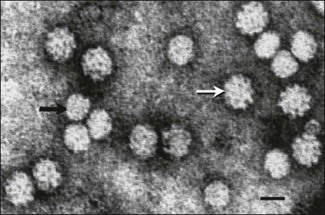Chapter 46 This family is relatively new and comprises viruses of vertebrates. Circoviruses are non-enveloped, icosahedral in structure and generally range from 20–26 nm in diameter. A distinctive capsid surface structure is visible in electron micrographs of circoviruses. Chicken anaemia virus is larger and has a more distinct surface structure than porcine circovirus or beak and feather disease virus (Fig. 46.1). The genome consists of a single molecule of circular negative-sense or ambisense single-stranded DNA and replication occurs in the nucleus of dividing cells by means of a circular, double-stranded replicative form of the viral genome. Genetic sequencing studies (Niagro et al. 1998) demonstrated the existence of three distinct groups within the family and this has led to classification changes including the creation of two new genera, Circovirus and Gyrovirus (Fig. 46.2). The third grouping, the plant circoviruses, has now been assigned to the family Nanoviridae. The viruses are stable in the environment at pH 3 to 9 and resistant to heat at 60°C for 30 minutes. Figure 46.1 Negative contrast electron microscopy of particles of an isolate of chicken anaemia virus (white arrow) and beak and feather disease virus (black arrow) stained with uranyl acetate. The bar represents 20 nm. Reprinted with permission: Fauquet CM (ed) et al. 2005 Virus Taxonomy Eighth Report of the International Committee on Taxonomy of Viruses, Elsevier Academic Press. Circoviruses are host-specific and have a worldwide distribution (Table 46.1). They are associated with infection of cells of the haemolymphatic system.
Circoviridae

![]()
Stay updated, free articles. Join our Telegram channel

Full access? Get Clinical Tree




